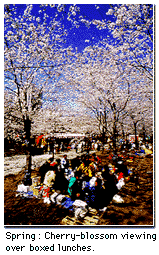 |
 Japan lies on the western edge of the Pacific Ocean and east of the Eurasian continent. It consists of several thousand islands and islets. Most of Japan is in the Temperate Zone and has a humid monsoon climate, with southeasterly winds blowing from the Pacific Ocean during the summer and northwesterly winds from the Eurasian continent in the winter. Japan lies on the western edge of the Pacific Ocean and east of the Eurasian continent. It consists of several thousand islands and islets. Most of Japan is in the Temperate Zone and has a humid monsoon climate, with southeasterly winds blowing from the Pacific Ocean during the summer and northwesterly winds from the Eurasian continent in the winter.
|
| The country's land area is 378,000 square kilometers, which is one twenty-fifth that of the United States, one-twentieth that of Australia, and 1.5 times that of Britain. |
 It has a population of 125 million, making Japan the world's eighth most populous nation. Nearly all the Japanese live on the four main islands of Hokkaido, Honshu, Shikoku, and Kyushu. It has a population of 125 million, making Japan the world's eighth most populous nation. Nearly all the Japanese live on the four main islands of Hokkaido, Honshu, Shikoku, and Kyushu.
Japan also has one of the world's highest population densities; there are 338.4 residents for every square kilometer of land. The figure for the United States is 28 and that for Britain is 239. Three-quarters of Japan is mountainous, and two-thirds is forested. Warm and cold currents wash into the seas around Japan, and many species of fish are caught in abundance. Japan has four distinct seasons, but because the country stretches for 3,000 kilometers along a north-south axis, its extremities, Hokkaido and Okinawa, have very different climates. Around the end of March, you can go sunbathing in the south and skiing in the north. Japan has 7,087 species of higher-order plants. There are 1,214 species of vertebrates and 35,207 species of invertebrates. The country often suffers such serious natural disasters as flooding from typhoons and torrential rain, volcanic eruptions, and earthquakes, but tornadoes are rare.
Photos courtesy of Tokyo Metropolitan Government.

|
